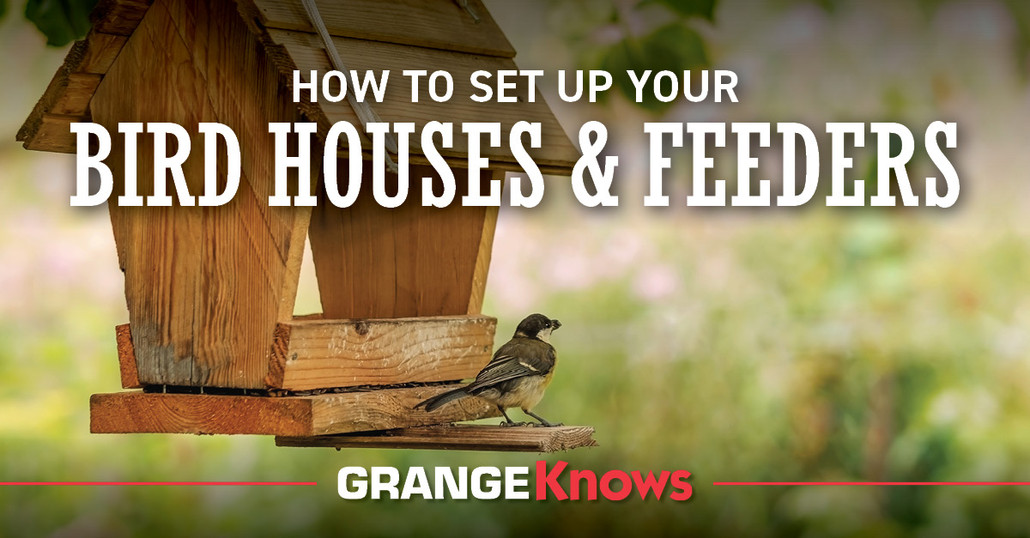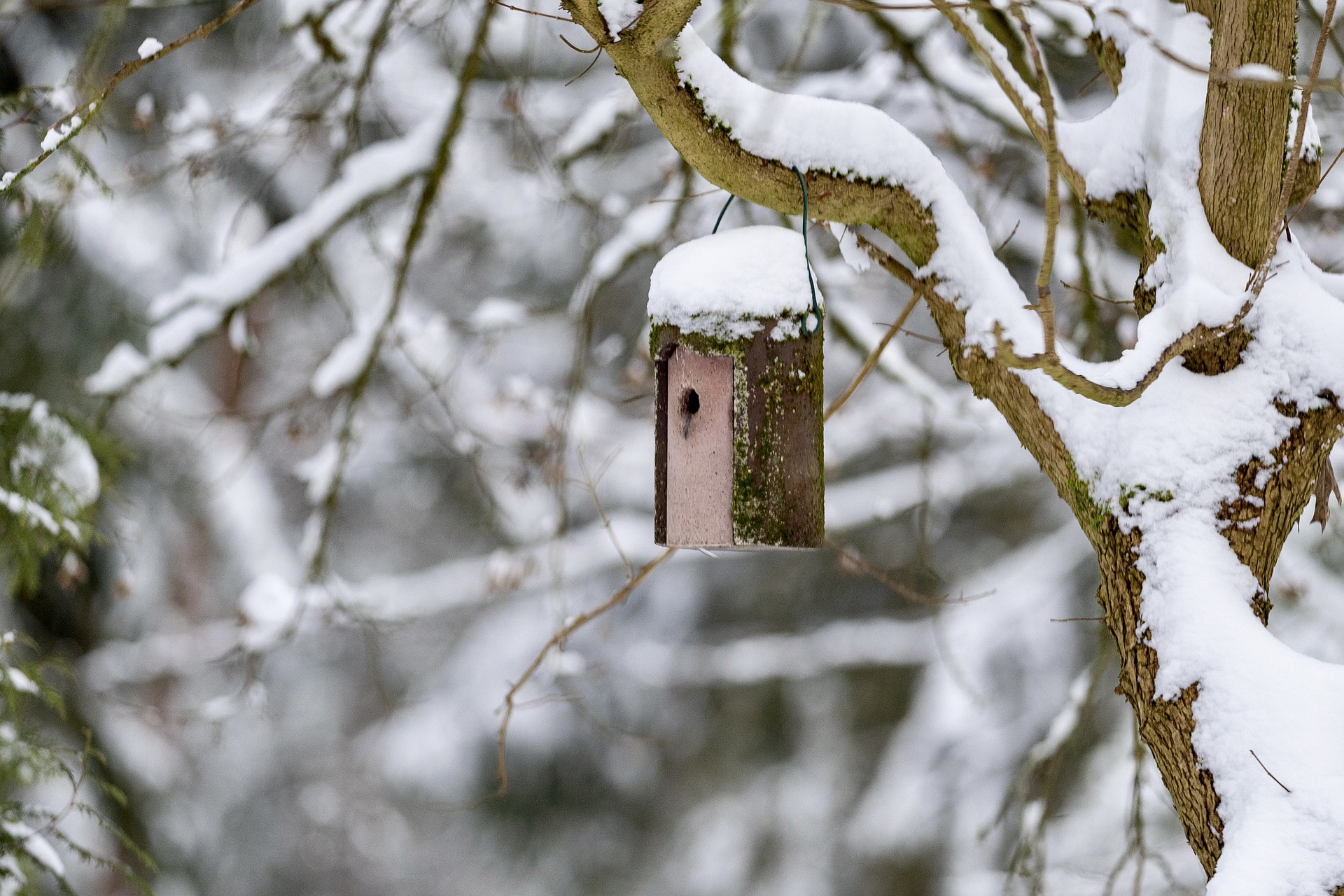
How to Set Up Your Birdhouses and Feeders
Posted by Grange Co-op on 18th Apr 2022
Nothing is more enjoyable than watching birds come and go in your backyard. One way to make your yard more inviting to your feathered friends is by providing them with a birdhouse where they can build their nests. Birdhouses protect the birds from the elements and keep them safe from predators. But it’s important to mount the birdhouse in the right place and in the right way.
Which Birds Use Birdhouses?

Nothing is more disappointing than putting up a new birdhouse only to have it remain vacant. Despite your best efforts, there are many reasons that birds might not choose to nest in your birdhouse. One reason is that not all birds nest in houses. Those that are cavity nesters — birds that build nests in holes in trees, rocks, or cliffs — are the primary residents of houses. Birds like bluebirds, house wrens, purple martins, sparrows, and chickadees are more likely to nest in a house.
Before purchasing a birdhouse or deciding where to put it, you should target which birds you want to attract. Do your research to find out which cavity nesters are common in your area. You may target one or more species depending on the cavity-nesting species where you live. Once you have your target species picked out, it’s time to choose the right birdhouse.
Decide How Many Birdhouses You Will Need
If you plan to set up multiple birdhouses, keep them at least 25 feet apart. This includes houses for the same or different species. Territorial species won’t allow other birds to nest nearby.
Choose the Right Size House for the Bird
The birdhouse needs to “fit” the type of bird you want to attract. While smaller birds such as the house sparrow prefer a smaller house that is 4 x 4 x 10”, larger species like the American kestrels need more room at about 8 x 8 x 12”. House finches and woodpeckers fit in between with a preferred house size of 6 x 6 x 12”.
The size of the entry hole matters, too. Make sure you choose the appropriate size for the bird you want to attract. Finally, the birdhouse needs to be at the right height. For example, to attract purple martins, place the house about 15 to 20 feet above the ground. A birdhouse for chickadees should be mounted between 4 and 8 feet over the floor of a thicket.
Select the Best Location
A common mistake among bird-watchers is that they place the birdhouse where they can monitor its use, not where it’s most convenient for the birds. Birds don't want to leave their nest to go find food. For bluebirds, that means facing the house opening toward a field where insects are plentiful. House wrens prefer a place near woody vegetation.
Position the Birdhouse Away from Predators
You might think your backyard is a safe haven for birds, but there might be predators or threats that you don’t see. These might include predatory birds, squirrels, snakes, your neighbor’s cat, or your house cat when you let it outdoors.
Many people’s first instinct is to hang a birdhouse on a tree branch. But that also makes it easy for any of these predators to gain access to the birdhouse.
Instead, put the birdhouse on a pole that discourages predators from entering. A round metal pole is best since it doesn’t facilitate climbing.
Don’t Put Birdseed in the Birdhouse
It seems like the perfect way to entice birds inside. Instead, putting birdseed inside the birdhouse could prevent birds from considering the place as home. Birdseed can attract predators and put the bird family at risk. The feed belongs in a bird feeder, and even that should not be close to the birdhouse.
Place a Bird Feeder and Birdbath Nearby
Birds need more than a place to sleep and nest. They need access to food and water, too. Although you don’t want the bird feeder too close to the birdhouse, it should be within easy access for the birds. Start by placing it about 10 feet from the house and then adjust the distance if needed.
The same is true for placing birdbaths. Don’t put the birdbath immediately below the birdhouse or feeder to prevent contamination. Try to maintain a 10-foot distance from the birdhouse and consider placing it in the shade if possible. This prevents the water from getting too hot and slows the evaporation rate.
One bird feeder is fine when you’re starting out. As your bird nesting population grows, you may want to increase the number of feeders and offer different types of birdseed. This will allow more birds and different species to feed at once.
Don’t Fill the Bird House with Nesting Material
Different species of birds prefer certain types of nesting materials. Filling the house with your choice might limit the types of birds that want to nest there. It’s better to leave the birdhouse empty and let the birds use the nesting materials they want.
Bird Feeder Maintenance
Once fed, many birds will rely on the supply and availability of this food, continuing to visit regularly. At Grange Co-op, we highly recommend the importance of maintaining the cleanliness of bird feeders in your yard. Caution should always be practiced as outside bird feeders and baths can spread pathogens, such as HPAI and H5NI, or otherwise known as 'bird flu'. Transmission in avian species is spread in the feces and respiratory secretions of infected birds. Avian scientists encourage emptying and cleaning bird feeders weekly. It is also important to note, that feeders must be cleaned between refillings - never "top off" without cleaning. Use a mild detergent and water; rinse thoroughly. Similarly, about once a month, soak the feeder in a solution of bleach and water (1 Tbsp. of bleach per quart of water); rinse very thoroughly! Additionally, some feeders can be put in the dishwasher for sterilization.
Know When to Set Your Birdhouses and Bird Feeders Up
Most people think of spring as the perfect time for setting up new birdhouses. But breeding and nesting seasons differ among bird species, too. You can put up birdhouses at any time, but it may be a while before the targeted species are ready to use them. Aim for late winter or early spring so that they are available for early nesters. Another option is to learn the nesting time for your targeted species and put the birdhouses and feeders out then.
It's Not Too Late to Put Out Birdhouses and Bird Feeders This Year
You will find a variety of products to help you attract birds to your backyard. If you need additional information about our bird feeders or any other wild bird products, contact us. We’re here to help you make the right choices to enhance your bird-watching experience.
